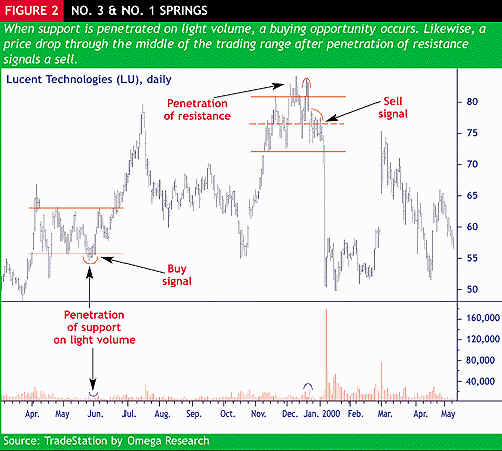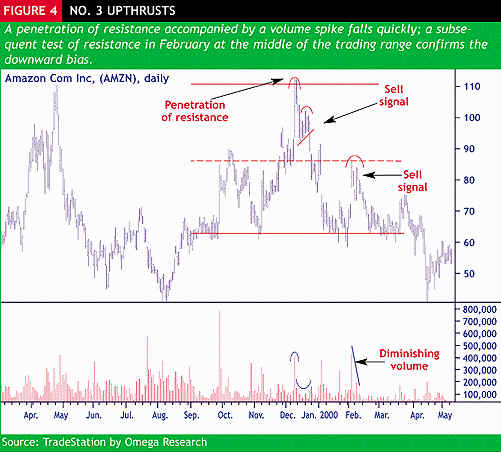Springs and Upthrusts
Picking tops and bottoms can be risky, but understanding concepts like Wyckoff’s springs and upthrusts allow you to identify low-risk, high-reward trade setups based on false breakouts.
Before the rudiments of technical analysis were spreading like wildfire via the Internet, bookstores and television, the general public or “the crowd,” would join a trend only after it had been well underway.
Nowadays, however, “the crowd” often rushes into a stock, a sector or a market at the first clue of a price breakout from a congestion zone. But as Joseph Granville, a famous technical analyst and trader, once said, “[In the markets], whatever is obvious is obviously wrong.”
So, if the crowd is rushing in at breakout time, who is left to take the other side of the trade? The answer is the better-informed professionals, who have conditioned themselves to act in accordance with another old saying, “One should fear to tread where fools rush in.” Hence, if you want to trade like the professionals, and not count yourself among the fools, you may want to sell a breakout rather than buy it — especially when the popular stocks of the day are under consideration.
To avoid being caught with the crowd, you should contemplate buying springs and selling upthrusts — two insightful, but often overlooked, principles of Richard D. Wyckoff, an early advocate of technical analysis who codified the best practices of the famous traders of the early 1900s. His principles and procedures, which came to be known as “the Wyckoff method,” are based on reading chart patterns.
Don’t expect to discover a set of precise mechanical rules with the Wyckoff method — instead, you’ll discover insights, general principles and guidelines that will help you interpret market behavior.
The Patterns
A spring is a price move below the support level of a trading range that quickly reverses and moves back into the range. A spring is an example of a “bear trap” because the drop below support appears to signal resumption of the downtrend. In reality, though, the drop marks the end of the downtrend, thus “trapping” the late sellers, or bears. The extent of supply, or the strength of the sellers, can be judged by the depth of the price move to new lows and the relative level of volume on that penetration.
An upthrust is the opposite of a spring. It’s a price move above the resistance level of a trading range that quickly reverses itself and moves back into the trading range. An upthrust is a “bull trap” — it appears to signal a start of an uptrend but in reality marks the end of the up move. The magnitude of the upthrust can be determined by the extent of the price move to new highs and the relative level of volume on that movement.
Springs and upthrusts are divided into three types — No. 3, No. 2 and No. 1.
The Rules
A No. 3 spring occurs when a modest penetration of support is accompanied by volume that is relatively light compared to the volume of prior down moves. The shallow price penetration and low volume indicate sellers are exhausted. No. 3 springs should be bought immediately.
No. 2 springs penetrate more deeply below support with greater comparative volume than No. 3 springs. This indicates sellers are still abundant during the break. Therefore, a second test of support is necessary before a buy can be signaled. After the initial break below support, price should move back about one-third into the trading range. Ideally, the volume for this up move should be higher than during the immediately preceding downswing, and also greater than volume of previous rallies within the trading range. The secondary test consists of a down move that, on comparatively light volume, usually retraces less than half the rally off the low established on the first downside penetration.
No. 1 springs are wholesale breakdowns below support on volume that is much larger than that of prior downswings within the trading range. Do not buy No. 1 springs; rather, look to sell short if the subsequent rally stops at or below the prior support (now resistance) level, especially if the move back to this level occurs on approximately half the volume of the initial breakdown.
Upthrusts are essentially mirror images of springs. A No. 3 upthrust is completed when, after penetrating resistance on large relative volume, price returns immediately to the average level of closing prices within the preceding range. The No. 3 upthrust is referred to as an “upthrust after distribution.” Sell No. 3 upthrusts immediately.
The No. 2 upthrust usually consists of a larger rally past resistance on greater comparative volume than No. 3 upthrusts. Like its No. 2 spring counterpart, however, a secondary test must be conducted before a sell signal is activated. After resistance is crossed initially, price should move back about one-third into the trading range. Volume for this move ideally should be greater than during the preceding upswing and higher than volume during the previous down moves. The secondary test consists of a rally that, on comparatively light volume, often retraces less than half the reaction from the immediately preceding high.
No. 1 upthrusts are legitimate upside breakouts that denote the start or resumption of an uptrend, and are usually accompanied by high volume. Rather than attempting to sell short, look to buy on a pullback that halts at or above prior resistance (now support), especially if the coinciding volume is no more than half the volume of the initial breakout.
In Practice
Let’s see how these patterns develop in real market situations. The first case involves Broadvision Inc. (BVSN), which formed a No. 2 spring in late January (see Figure 1). Price fell below support to 37 3/8 on high volume on Jan. 31 before springing back to the middle of the trading range at 51 3/4 on Feb. 3. A buy order was signaled when the stock fell back below 50 on light volume the next two trading days (the secondary test required of the No. 2 spring), with a stop-loss at the most recent low of 37 3/8. After breaking back above 50 on Feb. 8, Broadvision subsequently skyrocketed to 90 by early March.

The next two examples are in Lucent Technologies (LU). Figure 2 shows that Lucent, in late May 1999, fell below previously defined support near 56 on very light volume, immediately signaling a good buying opportunity in accordance with the rules for a No. 3 spring. The stock rallied strongly into July. Although Lucent slumped after the big increase, the stop-loss was never hit.

A new trading range developed in early November, with the stock trading between 72 and 82. When the resistance level was penetrated in mid-December, a short sale could have been executed around 78 — the point where the rally began to falter on relatively decreased volume. But a few days later, when the market fell through the approximate halfway point of the trading range, the sell signal was confirmed, with an accompanying stop-loss around the preceding high of 84 3/16.
Two more examples involve Computer Network Tech. Corp. (CMNT). These setups are practically identical, although they occurred at different times. Figure 3 shows CMNT formed a trading range in the 20 to 25 region during November and December 1999. The stock penetrated resistance toward the end of the year on increased volume, but soon fell back down below 22. The stock again attempted to rally, with price reaching 25 1/8 on Dec. 30, but it did so on diminishing volume. This failed rally completed the setup sequence for a No. 2 upthrust.
Another similar setup developed in February and March 2000. A selling opportunity arose when price began to decrease past the halfway point of the trading range in mid-March on decreasing volume. In both CMNT examples, stop-loss orders are placed at or just above the preceding highs.
Figure 4 shows the final examples, which involve Amazon.com (AMZN) and are a case of several intertwining situations. First, the stock formed a massive trading range between 62 and 110 from late-September 1999 to mid-April 2000. When the stock rose above 110 with a burst of volume in early December, only to turn back down again, it could have constituted a No. 3 upthrust and a sell short order could have been placed around 101 (where resistance for a much smaller trading range had formed). In early February, another short-selling opportunity presented itself when the market once again failed to rally past the halfway point of the range on diminishing volume.

Conclusions
By dividing upthrusts and springs into three separate categories, traders who study the Wyckoff method will be better able to evaluate market behavior around bear and bull traps.
The important thing to remember is that bottom fishing or top picking should not always be avoided or considered dangerous. Recognizing and understanding springs and upthrusts can help you locate reasonably high-reward, low-risk opportunities near the bottoms and tops of trading ranges.


Join the discussion